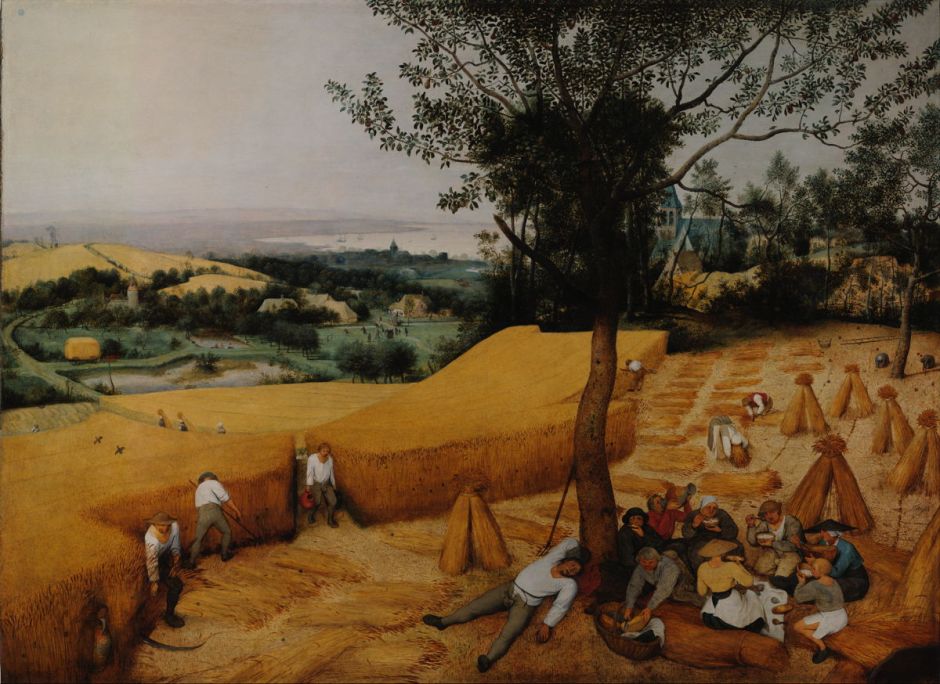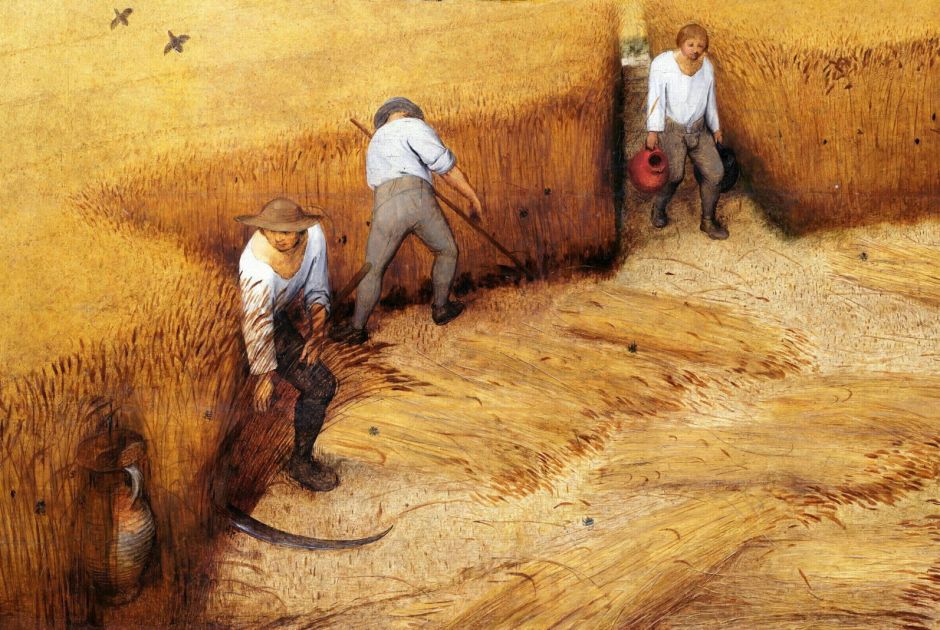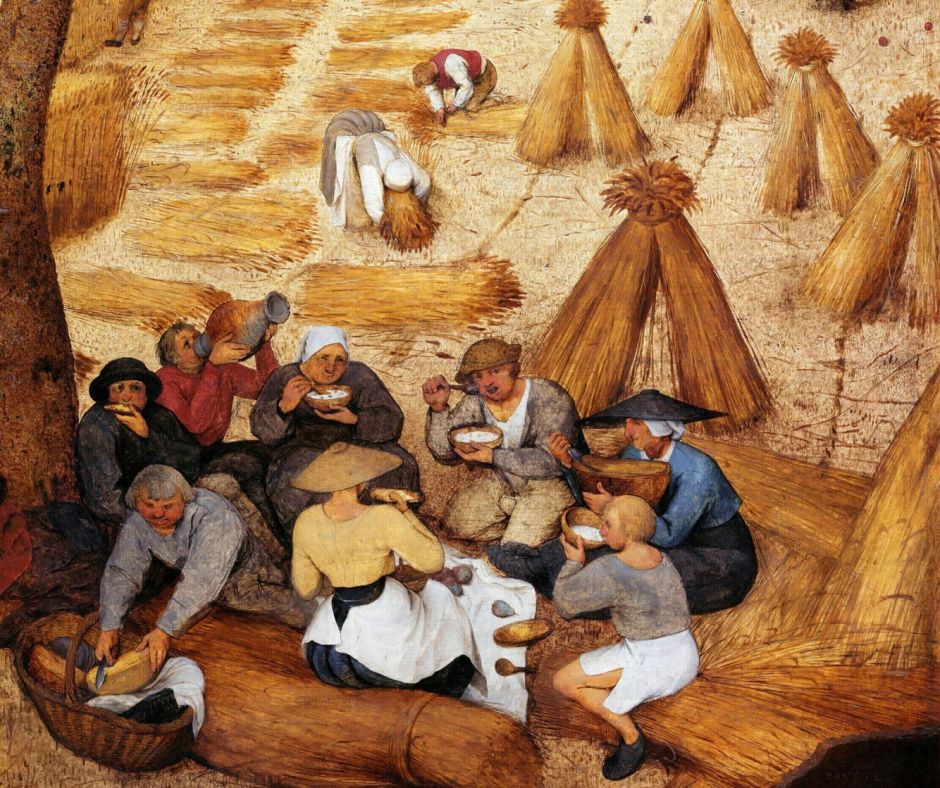The Real Country: 3 Cutting the corn
The climax of the year in arable farming is the harvest, when the sustained labour of the previous year pays off. For the farmer, this is the return on that investment, and for the labourers it’s when they hope to get paid their bonus. It’s the one time of the year when everyone turns to and works from before dawn until well after dusk in a united effort to harvest the ripe crop, before the weather breaks and it might be ruined.
The harvest depends on the crop being grown; as cereals, particularly wheat, were the most important across much of Europe, I’ll here concentrate on the processes required to turn them from ripe plants to grain ready for the miller to grind into flour. This article looks at the first step in that, cutting the crop, bundling it into sheaves and stacking those in stooks.
Current accounts of the grain harvest distinguish several tools used to cut the crop:
- handheld sickle, lightweight and normally with a serrated blade,
- handheld reaping hook, lightweight and with a smooth blade,
- handheld bagging or fagging hook, heavier and with a smooth blade, used in conjunction with a hooked stick or metal pick thank,
- long-handled scythe, heavy and held with both hands, with a smooth blade.
Some claim that reaping using a handheld sickle or hook was used for wheat and rye, but that barley and oats were more usually mown with a larger scythe. Although that doesn’t appear to be accurate, it’s clear that the use of scythes was considerably more efficient. While it took about 4 worker-days to cut an acre of grain using a sickle or hook, using a scythe typically took only 2 worker-days per acre. Scythes appear to have been used almost exclusively by men, while sickles and hooks were used by both men and women.
The tool used also determined the length of straw stalk cut with the head of grain, thus the height of the stubble left on the field. Sickles and hooks were often used when less straw was required, leaving high stubble that might be mown with a scythe later. Low reaping or bagging, or mowing with a scythe, created longer straw that was suitable for thatching.

Pieter Brueghel the Elder’s Harvesters from 1565 shows men cutting a crop of wheat close to the base of the stem using scythes, leaving short stubble. This ensures the best yield of straw as well as grain.


Behind these workers eating bread baked from flour ground from cereal grown in the same fields, cut cereal is tied first into sheaves before they’re gathered into stooks.

Anne Vallayer-Coster’s Garden Still Life, with Implements, Vegetables, Dead Game, and a Bust of Ceres (The Attributes of Hunting and Gardening) from 1774 shows at its left edge a long-handled scythe, and at the right a sickle or reaping hook. Scythes were also used extensively for mowing hay and weeds.

In about 1833, when Samuel Palmer painted his wonderful Harvest Moon near Shoreham in Kent, harvesting went on well into the night. These are mostly women wielding sickles or reaping hooks to cut a small field of wheat. The cut stalks are then formed into stooks and piled onto the oxcart for transport to nearby farm buildings.

Palmer’s mentor John Linnell painted The Harvest Cradle twenty-five years later, in 1859. The harvesters have their backs to the viewer, but appear to be using scythes to cut this wheat crop. Bundles of cut grain are tied as sheaves, then assembled into stooks in the foreground.

Jean-François Millet’s Ceres (The Summer) from about 1864-65 is unusual in that the goddess is shown holding a sickle with a serrated edge, and is surrounded by sheaves of wheat.

Léon Augustin Lhermitte’s famous Harvesters’ Pay from 1882 shows four harvesters, bearing their heavy-duty scythes, as they await payment by the farmer’s factor, who holds a bag of coins for the purpose. In the right foreground are two tied sheaves of cut wheat, with a lightweight sickle resting on them.

During the nineteenth century some attached cradles to the blade, to make sheaving easier. This is shown in Laurits Andersen Ring’s painting of Harvest. The crop being cut here may well be rye rather than wheat. The artist got his brother to model for this “monument to the Danish peasant” during the summer of 1885, while working on his farm near Fakse, on Sjælland (Zealand), Denmark.

Volodymyr Orlovsky’s Harvest in Ukraine from 1880 shows wheat being cut on the steppe, with the worker in the foreground carrying a scythe, but those cutting in the middle distance bent over as if using hooks instead.

The young woman in Mykola Pymonenko’s portrait of a Reaper from 1889 has been cutting what could be rye or wheat using a heavier bagging hook, although she isn’t using the hooked stick normally required for the technique, so could be using it as a regular reaping hook. The woman behind her demonstrates that these harvesters are cutting low to keep a good length of straw on the harvested crop.

Anna Ancher, wife of Danish painter Michael Ancher, caught this procession of Harvesters on their way to their work in 1905, near her home in Skagen on the north tip of Jylland (Jutland). The leader carries his scythe high as they pass through ripe wheat.
Finally, conventional corn stooks were by no means universal across Europe.

By tradition on Norwegian farms, cut corn (cereal) wasn’t left to dry in low stooks, as in most of Europe and America, but built onto poles. In a series of paintings and prints, Nikolai Astrup developed these Corn Stooks (1920) into ghostly armies standing on parade in the fields, the rugged hills behind only enhancing the feeling of strangeness.
These paintings suggest that, between 1550 and 1890, wheat was generally cut using scythes when suitable men were available. Otherwise, it would be cut using a hook, most likely for reaping rather than bagging. Wheat was normally cut low to preserve the stalk as straw suitable for thatching, then tied into sheaves before being stacked into stooks.
That left the fields ready for gleaning.